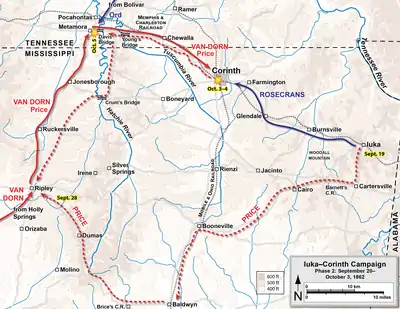4th Missouri Infantry Regiment (Confederate)
The 4th Missouri Infantry Regiment was an infantry regiment that served in the Confederate States Army during the American Civil War. Formed on April 28, 1862, the regiment was unengaged at the Battle of Farmington on May 9, and the Battle of Iuka on September 19. As part of Brigadier General Martin E. Green's brigade, the regiment participated in three charges against Union lines on October 3, 1862, during the Second Battle of Corinth. On October 4, the regiment joined Green's brigade in attacking the new Union lines. Despite initial success, the attack was repulsed by a Union counterattack. On November 7, 1862, the regiment was combined with the 1st Missouri Infantry to form the 1st and 4th Missouri Infantry Regiment (Consolidated); the 4th Missouri Infantry ceased to exist as a separate unit.
| 4th Missouri Infantry Regiment | |
|---|---|
| Active | April 28, 1862 to November 7, 1862 |
| Allegiance | |
| Branch | |
| Type | Infantry |
| Size | 547 (May 5, 1862) |
| Engagements | American Civil War |
The combined unit served in the Vicksburg campaign in 1863, before surrendering at the end of the Siege of Vicksburg. After being exchanged, the men rejoined the Confederate Army and served in the Atlanta campaign and the Battle of Franklin in 1864, still as part of the 1st and 4th Missouri Infantry Regiment (Consolidated). On May 9, 1865, the consolidated regiment surrendered during the Battle of Fort Blakely, ending the unit's combat tenure. The 4th Missouri Infantry's battle flag is displayed at the American Civil War Museum.
Background and organization
When the American Civil War began in 1861, the state of Missouri was politically divided, with substantial portions of the population holding either pro-secession or anti-secession beliefs. Governor Claiborne Fox Jackson was a secessionist and supported the Confederate States of America, and mobilized elements of the state militia in an effort to capture the St. Louis Arsenal. On May 10, Jackson's men were dispersed by Brigadier General Nathaniel Lyon of the Union Army; a pro-secession riot in St. Louis followed. Jackson responded by forming the Missouri State Guard (MSG) and appointing Major General Sterling Price as its commander. In June, Lyon evicted Jackson, the MSG, and the pro-secession elements of the state legislature from the state capital of Jefferson City. The secessionists retreated to southwestern Missouri, all the while pursued by Lyon.[1] On August 10, Lyon attacked the combined camp of the MSG and Confederate States Army elements commanded by Brigadier General Benjamin McCulloch, which was near Springfield. In the ensuing Battle of Wilson's Creek, Lyon was killed and his army routed.[2] Price followed up on his victory, leading the MSG north towards the Missouri River; by winter, Union reinforcements had chased them back into southwestern Missouri.[3] In the Battle of Pea Ridge, fought on March 7 and 8, 1862, in northwestern Arkansas, Price and the MSG suffered another defeat while serving under Major General Earl Van Dorn.[4] After Pea Ridge, Van Dorn's army was transferred east of the Mississippi River.[5] Eventually, many of the men of the MSG joined Confederate Army units.[6]
The 4th Missouri Infantry Regiment was formed on April 28, 1862, at Memphis, Tennessee. Two previously-existing battalions, commanded by Archibald A. MacFarlane and Waldo P. Johnson, were combined with a small element of the MSG; many of MacFarlane and Johnson's men were MSG veterans. MacFarlane was appointed the regiment's first colonel, Johnson was the first lieutenant colonel, and Stephen W. Wood was the regiment's first major.[7] On April 28, the regiment contained ten companies, all Missouri-raised; they were designated with the letters A–I and K.[8] Almost all of the regiment's soldiers were of Anglo-Saxon descent.[9]
Service history

After formation, the regiment was transferred using local railroads to Corinth, Mississippi, as part of the Army of the West.[10] A muster, carried out on May 5, counted 547 men in the regiment.[11] On May 9, the 4th Missouri Infantry was near the action at the Battle of Farmington and deployed, but did not enter the fray. After the Confederates evacuated Corinth due to Union pressure, the regiment trained in various locations in northern Mississippi.[10] Price was in command of the Army of the West, which he had stationed at Iuka, Mississippi; Van Dorn had troops further to the south. The Confederates were conducting an offensive into Kentucky, and Price and Van Dorn were expected to move into Tennessee to support it. Major General Ulysses S. Grant, who was the Union commander in the region, decided to attack Price before he was joined by Van Dorn. Grant divided his 17,000 men into two wings to attack Price from multiple directions. On September 19, Price fought his way past one wing of Grant's army in the Battle of Iuka; the other wing did not hear the sound of fighting due to an acoustic shadow and did not participate.[12] The 4th Missouri Infantry was in Brigadier General Martin E. Green's brigade, which was held in reserve and did not fight at Iuka.[10]
After escaping, Price joined Van Dorn, who commanded the combined force. Together, the Confederates moved against Corinth, which was strategically important to Union plans in the region. On October 2, Union Major General William S. Rosecrans occupied Corinth with 23,000 men; that same day, he learned of Van Dorn's approach. After arriving near the city, the Confederates deployed in an arc northwest of the Union defenses with 22,000 men. At 10:00 on October 3, Van Dorn attacked, beginning the Second Battle of Corinth.[13] At Corinth, the 4th Missouri Infantry made up part of Green's brigade, which was in Brigadier General Louis Hébert's division; Hébert's formation was in turn part of Price's corps within the Army of West Tennessee.[14] The 4th Missouri Infantry and the rest of Green's brigade (except for the artillery) attacked an outer Union position held by Brigadier General Thomas A. Davies's division. The initial attack was repulsed, but Green ordered a second charge. The second charge was again repulsed, this time by a Union counterattack led by the 2nd Iowa Infantry.[15] Later in the afternoon, Green's brigade made another charge against Davies's line, although this attack was supported by elements of Colonel Elijah Gates's and Brigadier General Charles W. Phifer's brigades. After heavy fighting, the Union line was broken. Despite a clear line of attack against the inner Union line being open, Price decided not to press the attack as only 30 remaining minutes of daylight; instead he waited for the morning of the 4th to resume the battle.[16]
On October 4, Green was promoted to divisional command due to Hébert falling ill. Command of Green's brigade then fell to Colonel William H. Moore,[17] who led a charge against the inner Union line, with the objective of the attack a fortification known as Battery Powell. The Union line was defended by men of Davies's division, who were quickly routed by the Confederate charge.[18] After breaking through Davies's line, Moore's brigade aimed for the town of Corinth itself.[19] Along with elements of Phifer's brigade and the brigade of Brigadier General John C. Moore, it entered Corinth, and penetrated as far as the Tishomingo Hotel. However, a Union counterattack drove the Confederates out of Corinth.[20] At Second Corinth, the 4th Missouri lost 15 men killed, 87 wounded, and 27 missing, for a total of 129.[10] MacFarlane suffered a serious head wound during the battle.[8][21]
Legacy

On November 7, in the vicinity of Wyatt, Mississippi, the regiment consolidated with the 1st Missouri Infantry, due to losses in both units. The combination of the two regiments formed the 1st and 4th Missouri Infantry Regiment (Consolidated).[10] Companies B, C, E, H, and I of the new regiment were composed of men from the 4th Missouri Infantry; Companies A, D, F, G, and K were composed of men from the 1st Missouri Infantry.[22] MacFarlane and Colonel Amos C. Riley of the 1st Missouri Infantry came to an agreement whereby McFarlane became colonel of the unit and Riley lieutenant colonel; the latter commanded the unit while MacFarlane recovered from his wounds.[23] As a result of the consolidation, about 40 officers were deemed superfluous and were sent back across the Mississippi River to recruit new soldiers.[24]
In 1863, the new regiment fought at the Battle of Grand Gulf, the Battle of Champion Hill, the Battle of Big Black River Bridge, and the Siege of Vicksburg, where the regiment was captured as part of the Confederate surrender. The men of the regiment were then exchanged, and rejoined the Confederate army, still under the designation of the 1st and 4th Missouri Infantry Regiment (Consolidated). In 1864, the regiment was engaged at the Battle of New Hope Church, the Battle of Kennesaw Mountain, the Siege of Atlanta, the Battle of Allatoona, and the Battle of Franklin. On May 9, 1865, the 1st and 4th Missouri Infantry (Consolidated) surrendered at the Battle of Fort Blakely, ending the unit's combat experience.[22]
As of January 2021, the flag of the 4th Missouri Infantry, a Van Dorn battle flag, is held by the American Civil War Museum in Richmond, Virginia.[25][26]
References
- Kennedy 1998, pp. 19–20.
- Hatcher 1998, pp. 21, 23.
- Kennedy 1998, pp. 23–25.
- Shea & Hess 1998, pp. 34, 36–37.
- Kennedy 1998, p. 38.
- Gottschalk 1991, p. 120.
- McGhee 2008, pp. 200–201.
- McGhee 2008, p. 200.
- Tucker 1993, p. 93.
- McGhee 2008, p. 201.
- Gottschalk 1991, p. 108.
- Kennedy 1998, p. 129.
- Reaves 1998, pp. 130–131.
- Cozzens 1997, p. 327.
- Cozzens 1997, pp. 205–207.
- Cozzens 1997, pp. 210–214.
- Cozzens 1997, pp. 235–236.
- Cozzens 1997, pp. 240–242.
- Cozzens 1997, p. 245.
- Cozzens 1997, pp. 267–269.
- Tucker 1993, p. 92.
- McGhee 2008, pp. 181–184.
- Tucker 1993, pp. 93–94.
- "Sitton, John James (1842–1915)" (PDF). The State Historical Society of Missouri. Retrieved January 24, 2021.
- Dedmondt 2009, pp. 83–84.
- "Object Record 0985.08.00014". American Civil War Museum. Retrieved January 24, 2021.
Sources
- Cozzens, Peter (1997). The Darkest Days of the War: The Battles of Iuka and Corinth. Chapel Hill, North Carolina: University of North Carolina Press. ISBN 978-0-8078-2320-0.
- Dedmondt, Glenn (2009). The Flags of Civil War Arkansas. Gretna, Louisiana: Pelican Publishing Company. ISBN 978-1-58980-190-5.
- Gottschalk, Phil (1991). In Deadly Earnest: The Missouri Brigade. Columbia, Missouri: Missouri River Press. ISBN 978-0-9631136-1-0.
- Hatcher, Richard (1998). "Wilson's Creek, Missouri". In Kennedy, Frances H. (ed.). The Civil War Battlefield Guide (2nd ed.). Boston/New York: Houghton Mifflin. ISBN 978-0-395-74012-5.
- Kennedy, Frances H., ed. (1998). The Civil War Battlefield Guide (2nd ed.). Boston/New York: Houghton Mifflin. ISBN 978-0-395-74012-5.
- McGhee, James E. (2008). Guide to Missouri Confederate Regiments, 1861–1865. Fayetteville, Arkansas: University of Arkansas Press. ISBN 978-1-55728-870-7.
- Reaves, George A. (1998). "Corinth, Mississippi". In Kennedy, Frances H. (ed.). The Civil War Battlefield Guide (2nd ed.). Boston/New York: Houghton Mifflin. ISBN 978-0-395-74012-5.
- Shea, William L.; Hess, Earl J. (1998). "Pea Ridge, Arkansas". In Kennedy, Frances H. (ed.). The Civil War Battlefield Guide (2nd ed.). Boston/New York: Houghton Mifflin. ISBN 978-0-395-74012-5.
- Tucker, Phillip Thomas (1993). The South's Finest: The First Missouri Confederate Brigade From Pea Ridge to Vicksburg. Shippensburg, Pennsylvania: White Mane Publishing Co. ISBN 978-0-942597-31-8.
Further reading
- Bryan, William (2014). A Socio-Military History of the Fourth Missouri Infantry Regiment, C.S.A. (Master's thesis). Missouri State University.